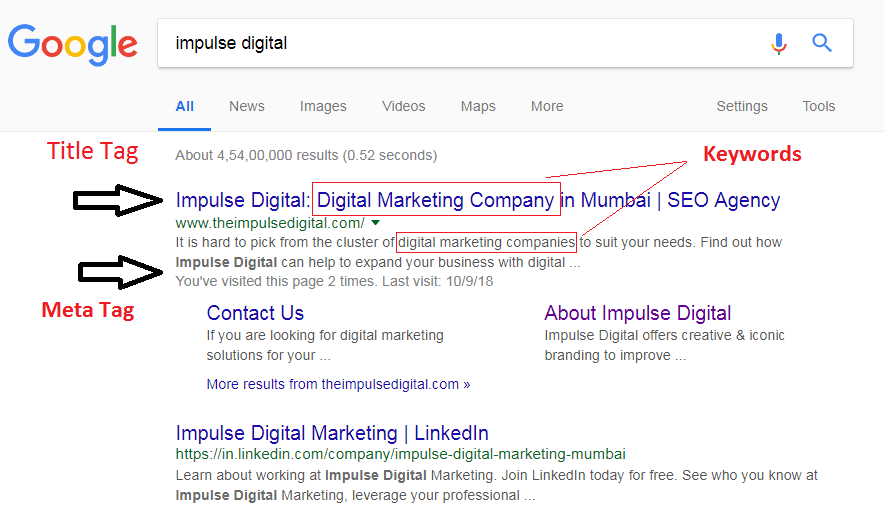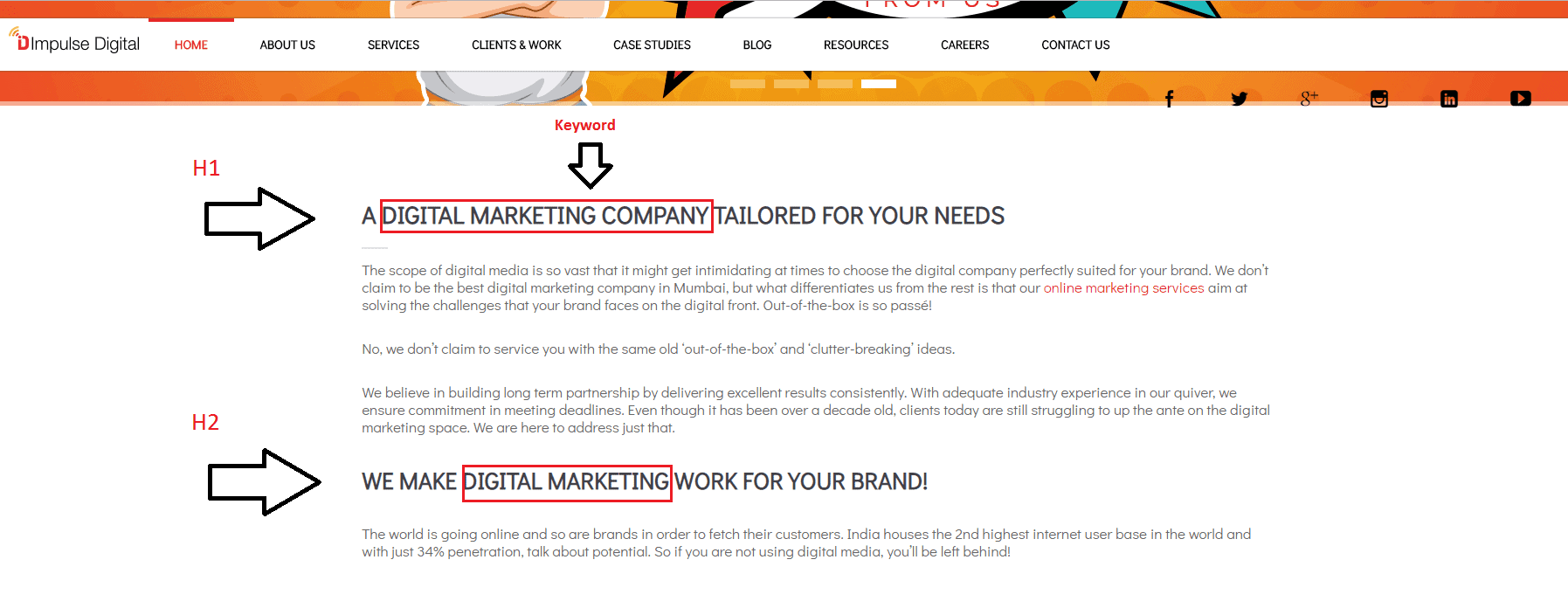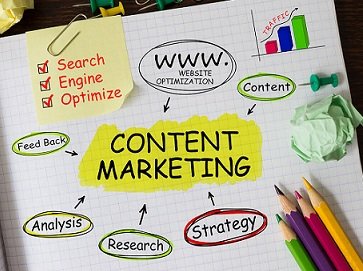
Being a content marketing company, we are constantly creating, monitoring and optimizing content for our clients. We simply cannot stress enough on how indispensable it is to create the right content and to distribute it through the right channels at the right time for your business goals.
Content being one of the top ranking factors for Google’s ‘organic’ search, optimising your content not only helps you increase your SERP but also helps you built credibility in the eyes of the audience. Hence, it’s important to have a continuous and effective content strategy in place. Here are some simple and effective ways to get started with.
1. Keyword Research
Keywords are nothing but the search queries that you type on Google. It is always advisable to do a thorough keyword research before one starts developing content.
– Always optimize for keywords that have a good amount of search volume. In this case, you are certain that these keywords have an existing traffic and you can try to tap into that audience.
– The content should be developed around the keywords you wish to improve your rankings for. Often, people write content for their businesses first and then try to force fit the keywords. You can use ‘Moz Keyword Explorer’ to know relevant keyword’s overview for your business.
– Don’t stuff keywords, Google’s algorithms are smart enough to catch websites that are merely spamming their content with keywords. Gone are the days of keyword stuffing.
– The flow of the keywords in your content should be natural. It shouldn’t appear that you are trying hard to stuff the relevant keywords.
– If you are a new business, try to optimise for keywords that have a middle volume search as the big players with well established businesses already have a vantage in terms of optimising for keywords with a very high volume of search queries.
– Try optimizing for long-tail keywords as they are more specific. Short tail keywords may have a high volume of search but it is extremely difficult to rank higher in those keywords and the conversations too are low. Long tail keywords have a high conversion rate as well as they are easier to optimize.
– Try to know for what keywords your competitors have a high ranking. It can be done by using websites like ‘SEMrush’ or ‘Unfollowspy’. Try and compete for those keywords.
– Always try to optimise on brand keywords. You don’t want your prospective audience to land on any bike comparison websites while they are specifically looking for your bike brand.
2. Inserting Keywords
Title tag – They are extremely important in your SEO optimization strategy. It helps Google as well as the users to understand what the page is all about. You must use keywords in the title tag. E.g ‘Digital Marketing’ for Impulse Digital.
Meta tags – Meta tags are the short descriptions of what lies inside the webpage. It is advisable to use the keywords in the meta tags as well.

Header Tags – H1 to H6 are the headings and sub-headings on the webpage. These headings as well are instrumental in making the crawlers understand what your website is all about. H1 is the most important amongst all. Make sure to include the keywords in them as well.

3. Aligning your business goals to the content format
Your SEO strategy can have many different goals like attracting traffic to your blogs, driving sales, trying to earn more revenue by the ads on your websites, etc. It is extremely important that you choose the right format to deliver your content. You can choose from videos, blogs, videos, info graphics, articles and many other options that are available.
4. Creating the content
– Make sure that your content is authentic. Plagiarism is a big no-no.
– To ensure that the bounce rate is low, make sure that you deliver exactly what your audience is looking for. Be precise and to the point. If they are not able to find the required information easily, the bounce rate of your website will increase, reducing your credibility in the eyes of Google which may affect your SERP.
– The language of your content must be in sync with the target audience. If it’s a blog for the general audience, it’s advisable to use simple vocabulary and simple sentence structure. This will make sure that they consume more content and don’t bounce off the website.
– Avoid big paragraphs and extremely long sentences. Use bullets, highlights etc. so that consuming volumes of content becomes easy. A lot of the audience is merely going to scan and skim through the page rather than read every written word. Structuring the content in such a format that it’s easy to merely go through is also important for that section of the audience that’s looking for quick reads.
– Use correct call to actions (CTAs)
– Check for spelling mistakes, grammatical errors, punctuation errors, etc. Read it a couple of times and make someone else proof read it for you as well.
– Make it interesting. If you want your audience to keep coming back and consuming more of the content that you are creating, make sure that u make it interesting by adding statistics, good graphics, etc.
– Alt tags are descriptions of the images that you have added. Adding alt tags helps Google read out and describe the images to the visually impaired readers. Adding alt tags is also an important feature of SEO.
– Hire a good copywriter if required who knows how to create SEO content.
5. Monitoring and scheduling content
Content optimization is a continuous process. You don’t just have to keep creating content but also monitoring it and improvising it regularly.
– Monitor which content of yours does better than the others and try to understand why.
– Try to follow a schedule and post accordingly. Create a social media timetable.
– Keep a tab on what kind of content your competitors are making. You can take inspiration from that content.
While these are some of the ways one can optimise content for SERP. However, no matter how good your content is, it is equally important that you also optimise the technical aspects of your website so that your content actually reaches your target audience. We have covered the technical aspects of SEO in this blog.
We would like to conclude by saying that it takes time for your SEO efforts to show results unlike SME. Hence, once you are done working on your content strategy, just relax and enjoy a cup of coffee and let the Google web crawlers do their job!
Was this article useful to you? Or you want to add a few more points? Write to us at [email protected] or connect to us on Facebook / Twitter / or Instagram.



Really Helpful blog..Thank you
I got such a good information on this topic its very interesting one. You made a good site
Hey Raja, Thank you for kind words. 🙂 We always try to come up with blog topics that interest our readers.
This is really helpful information everything explained properly and easy to understand for me. thank you for sharing this information with us.
Glad you liked our post and thank your for your positive words.